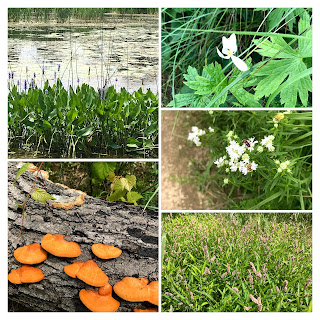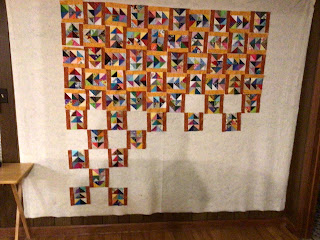Signs of progress: the Zion Woman's Club board and the AAUW Waukegan Branch board met this week. Both groups met in person for the first time in over a year. It was so good to be together!
(Left: though this is specifically AAUW, it's representative of the other groups I'm in. Sitting next to one another in someone's living room after a potluck dinner!)

Stevens and I made several visits to different parts of Illinois Beach State Park and also to one of the forest preserves this past week. Here are just some of the many photos I took.
This was the first time I'd taken the Dead River loop (red on the map). I went south that way and came north on the Dunes loop (yellow).
I waded in the lake today. I have water shoes to protect my feet from the stones. I had a nice chat about local history with a man who was taking his dog to the beach. The man said that paths like the one on the upper right photo are the remnants of streets from the days when there were houses along the lakefront. (In those days the lake was about 1000 feet farther out than it is today, due to severe erosion.)
Right: compass plant, bull thistle, nodding onion, cutleaf coneflower, sensitive fern, catnip.

I picked a half-dozen of the ripest blackberries. They were still very tart. Lower left: hoary verbena. Upper right: harebell (another name is Evil Twin!), bittersweet (also climbing spindleberry, "an opportunistic climber and climbs any available tree or structure"), toadflax or butter-and-eggs.
Left: pickerelweed in the Dead River, a Hallowe'en log (the shelf fungus was very hard). Right: anemone, mountain mint, lady's thumb.
# # # # # # # #
I have assembled the blocks for the wedding quilt.
I haven't figured out the sashing between the blocks but I've begun assembling the border blocks.
I'm ahead of schedule with this project. Barb-the-quilter has it on her calendar for early September. I gave myself extra time just in case. That means that I have not planned out or begun the guild challenge. The challenge reveal was going to be at the August 4 meeting. We will be Zooming again because of a conflict in the meeting place schedule, so maybe they'll have the reveal in September. I will have to check.
"The goal of this work [is] not to resolve all of the problems of a millenia-old phenomenon but to cast a light into its history, its consequences and its presence in our everyday lives." (p. 380)I learned a lot from Wilkerson's descriptive history of caste vs. class, with comparisons of racism in the U.S. to the Nazi persecution of Jews (and other groups they deemed inferior) and to the centuries-old Indian caste system. I am the audience to whom she's pitching: a member of the "dominant" ethnic/racial group (the story of the three white American women self-identifying by family origin was familiar). "The injustice!" is a natural reaction to the stories, both historical (beatings, lynchings) and contemporary (Wilkerson's own lived experience during her reporting career).Wilkerson's description ends with the beginning of the prescription: "All of us can sharpen our powers of discernment to see past the external and to value the character of a person rather than demean those who are already marginalized or worship those born to false pedestals." (p. 380) "WE had nothing to do with having been born into privilege or under stigma. We have everything to do with what we do with our God-given talents and how we treat others in our species from this day forward....We are responsible for what good or ill we do to people alive with us today." (p. 387)I, for one, hope I can be more discerning, patient, empathetic, and kind.
~~~~~~~~~~~~~~~~~~~~~~~~~
I very much enjoyed this thoroughly detailed history of a specific collection of quilted textiles. Each piece is placed in context with as much as can be known about the maker, about the type of fabric used, and about the sewing techniques. I learned a great deal about the English-American textile industry and the transatlantic trade. In 2009 a traveling exhibition of Winterthur quilts made a stop at the Milwaukee Art Museum. (I'm sure this book was in the gift shop but I wouldn't have paid the $40 list price. Fortunately in July, 2021, the book on the giveaway table at the quilt guild meeting and I took it! Waiting paid off.)
The Scarlet Thread, published in 1956, is the second of five mysteries featuring Gil Donan, a part time sheriff's deputy and part time potter who lives on an island off the coast of Maine. ("Note! Fox Island is purely fictional It lies nor'-nor'-east or sou'-sou'-west, as the reader may wish, of Vinalhaven and North Haven Islands. Any resemblance to real Penobscot Bay folks is entirely coincidental.")
A beautiful young woman from exotic New Mexico has rented the old Bickford house. When she is found dead from a fall down the stairs Gil Donan investigates. A cast of eccentric characters includes lobstermen, the town librarian, the sisters who run the dry goods shop, the town doctor, the undertaker, wealthy summer people. Who did it -- and why?
I came across this copy at an antiques mall a few weeks ago. It was $3.00 (original price $2.75, which would be about $28 today). It was discarded from the public library in Menominee, Michigan. Its last due date was was March 12, 1970. Where has it been for 51 years?
I worked at public library in Auburn, Maine, for 11-1/2 years. I read many books about Maine and a lot of mysteries -- and many Maine mysteries. I don't recall seeing any books by Margaret Page Hood. I looked her up. She was born in Connecticut in 1891. By the time she wrote the Gil Donan mysteries she spent winters in Las Cruces, New Mexico, and summers on Vinalhaven. (In The Scarlet Thread there are references to Old Mesilla, the old neighborhood of Las Cruces.) She died in Las Cruces in 1983.The Maine State Library has correspondence between her and the librarian in charge of the Maine Authors Collection.
(I'm going to try to track down the other books in the series.)


















































